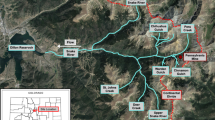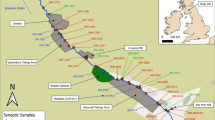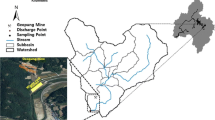Abstract
Effective remediation requires an understanding of the relative contributions of metals from all sources in a catchment, and that understanding must be based on a spatially detailed quantification of metal loading. A traditional approach to quantifying metal loading has been to measure discharge and chemistry at a catchment outlet. This approach can quantify annual loading and the temporal changes in load, but does not provide the needed spatial detail to evaluate specific sources, which is needed to support remediation decisions. A catchment or mass-loading approach provides spatial detail by combining tracer-injection and synoptic-sampling methods to quantify loading. Examples of studies in American Fork, Utah, and its tributary Mary Ellen Gulch illustrate this different approach. The mass-loading study in American Fork treated Mary Ellen Gulch as a single inflow. From that point of view, Mary Ellen Gulch was one of the greatest sources of Fe, Mn, Zn, and colloidal Pb loads to American Fork. But when Mary Ellen Gulch was evaluated in a separate catchment study, the detailed locations of metal loading were identified, and the extent of metal attenuation upstream from the mouth of Mary Ellen Gulch was quantified. The net, instantaneous load measured at the mouth of Mary Ellen Gulch for remediation planning would greatly underestimate the contributions of principal sources within the catchment. Extending the detailed sampling downstream from Mary Ellen Gulch indicated the possibility of diffuse groundwater inflow from Mary Ellen Gulch to American Fork. Comparing loads for Mary Ellen Gulch in the two studies indicates that metal loads could be substantially underestimated for planning purposes without the detailed catchment approach for the low-flow conditions in these studies. A mass-loading approach provides both the needed quantification of metal loading and the spatial detail to guide remediation decisions that would be the most effective in the catchments.










Similar content being viewed by others
References
Aulenbach BT (2006) Annual dissolved nitrite plus nitrate and total phosphorous loads for the Susquehanna, St Lawrence, Mississippi-Atchafalaya, and Columbia river basins, 1968–2004. US Geological Survey Open-File Report 2006-1087, 12 pp
Aulenbach BT, Hooper RP (2006) The composite method: an improved method for stream-water solute load estimation. Hydrol Process 20:3029–3047
Baker AA, Calkins FC, Crittenden MD Jr, Bromfield CS (1966) Geologic map of the Brighton Quadrangle, Utah. US Geological Survey Quadrangle Map GB-534, 1 pp
Barringer JL, Johnsson PA (1989) Theoretical considerations and a simple method for measuring alkalinity and acidity in low pH waters by Gran titration. US Geological Survey WRI Report 89-4029, 35 pp
Bencala KE, McKnight DM (1987) Identifying in-stream variability: sampling iron in an acidic stream. In: Averett RC, McKnight DM (eds) Chemical quality of water and the hydrologic cycle. Lewis Publishers, Chelsea, pp 255–269
Besser JM, Brumbaugh WG, May TW, Church SE, Kimball BA (2001) Bioavailability of metals in stream food webs and hazards to brook trout (Salvelinus fontinalis) in the Upper Animas River Watershed, Colorado. Arch Environ Contamin Toxicol 40:48–59
Brinton TI, Antweiler RC, Taylor HE (1996) Method for the determination of dissolved chloride, nitrate, and sulfate in natural water using ion chromatography. US Geological Survey OFR 95-426A, 16 pp
Broshears RE, Bencala KE, Kimball BA, McKnight DM (1993) Tracer-dilution experiments and solute-transport simulations for a mountain stream, Saint Kevin Gulch, Colorado. US Geological Survey WRI Report 92-4081, 18 pp
Buxton HT, Nimick DA, von Guerard PB, Church SE, Frazier AG, Gray JR, Lipin BR, Marsh SP, Woodward DF, Kimball BA, Finger SE, Ischinger LS, Fordham JC, Power MS, Bunck CM, Jones JW(1997) A science-based, watershed strategy to support effective remediation of abandoned mine lands. Abstract, Proceedings of the 4th international conference on acid rock drainage, vol 4. Vancouver, British Columbia, Canada, p 1867
Church SE, Kimball BA, Fey DL, Ferderer DA, Yager TJ, Vaughn RB (1997) Source, transport, and partitioning of metals between water, colloids, and bed sediments of the Animas River, Colorado. US Geological Survey OFR 97-151, 135 pp
Davis JC (2002) Statistics and data analysis in geology, vol 3. Wiley, NY, p 638
Gammons CH, Milodragovich L, Belanger-Woods J (2007) Influence of diurnal cycles on monitoring of metal concentrations and loads in streams draining abandoned mine lands: an example from high ore Creek, Montana. Environ Geol 53:611–622
Horowitz AJ, Elrick KA, Smith JJ (2001) Annual suspended sediment and trace element fluxes in the Mississippi, Columbia, Colorado, and Rio Grande drainage basins. Hydrol Proc 15:1169–1207
Kaufman L, Rousseeuw PJ (1990) Finding groups in data: an introduction to cluster analysis. Wiley, NY, p 368
Kilpatrick FA Cobb ED (1985) Measurement of discharge using tracers. US Geological Survey Techniques of Water-Resources Investigations, Book 3, Chap A16, 27 pp
Kimball BA, Broshears RE, Bencala KE, McKnight DM (1994) Coupling of hydrologic transport and chemical reactions in a stream affected by acid mine drainage. Environ Sci Technol 28:2065–2073
Kimball BA, Callender E, Axtmann EV (1995) Effects of colloids on metal transport in a river receiving acid mine drainage, Upper Arkansas River, Colorado, USA. Appl Geochem 10:285–306
Kimball BA, Nimick DA, Gerner LJ, Runkel RL (1999) Quantification of metal loading in Fisher Creek by tracer injection and synoptic sampling, Park County, Montana, August 1997. US Geological Survey WRI Report 99-4119, 40 pp
Kimball BA, Runkel RL, Walton-Day K, Bencala KE (2002) Assessment of metal loads in watersheds affected by acid mine drainage by using tracer injection and synoptic sampling: Cement Creek, Colorado, USA. Appl Geochem 17:1183–1207
Kimball BA, Runkel RL, Walton-Day K (2003) Use of field-scale experiments and reactive solute-transport modelling to evaluate remediation alternatives in streams affected by acid mine drainage. In: Jambor JL, Blowes DW, Ritchie AIM (eds) Environmental aspects of mine wastes. Mineralogical Association of Canada, British Columbia, pp 261–282
Kimball BA, Nordstrom DK, Runkel RL, Vincent KR, Verplanck PL (2006a) Questa baseline and pre-mining ground-water quality investigation. 23. Quantification of mass loading from mined and unmined areas along the Red River, New Mexico. US Geological Survey Scientific Invest Report 2006-5004, 44 pp
Kimball BA, Runkel RL, Walton-Day K, Williamson JE (2006b) Quantification of mass loading to Strawberry Creek near the Gilt Edge mine, South Dakota. US Geological Survey Scientific Invest Report 2006-5006, 41 pp
Kimball BA, Bianchi F, Walton-Day K, Runkel RL, Nannucci M, Salvadori A (2007) Quantification of changes in metal loading from storm runoff, Merse River (Tuscany, Italy). Mine Water Environ 26:209–216
Kimball BA, Runkel RL, Gerner LJ (2009) Methods and basic data from mass-loading studies in American Fork, October 1999, and Mary Ellen Gulch, Utah, September 2000. US Geological Survey Data Series Report 2009-443, 34 pp
Lichte FE, Golightly DW, Lamothe PJ (1987) Inductively coupled plasma-atomic emission spectrometry. In: Baedecker PA (ed), Methods for geochemical analysis, US Geological Survey Bull 1770, p B1-B10
Mayes WM, Gozzard E, Potter HAB, Jarvis AP (2008) Quantifying the importance of diffuse minewater pollution in a historically heavily coal mined catchment. Environ Pollut 151:165–175
Miller JR, Miller SMO (2007) Contaminated rivers: a geomorphological-geochemical approach to site assessment and remediation. Springer, Dordrecht, p 418
Nimick DA, Gammons CH, Cleasby TE, Madison JM, Skaar D, Brick CM (2003) Diel cycles in dissolved metal concentrations in streams: occurrence and possible causes. Water Resour Res 39:1247. doi:10.1029/WR001571
Runkel RL, Kimball BA, McKnight DM, Bencala KE (1999) Reactive solute transport in streams: a surface complexation approach for trace metal sorption. Water Resour Res 35:3829–3840
Runkel RL, Kimball BA, Walton-Day K, Verplanck PL (2007) A simulation-based approach for estimating premining water quality: Red Mountain Creek, Colorado. Appl Geochem 22:1899–1918
Sarmiento JL, Sundquist ET (1992) Revised budget for the oceanic uptake of anthropogenic carbon dioxide. Nature 356:589–593
Schemel LE, Kimball BA, Bencala KE (2000) Colloid formation and metal transport though two mixing zones affected by acid mine drainage near Silverton, Colorado. Appl Geochem 15:1003–1018
Smith KS (1999) Metal sorption on mineral surfaces: an overview with examples relating to mineral deposits. In: Plumlee GS, Logsdon MJ (eds) The environmental geochemistry of mineral deposits part a: processes, techniques, and health issues. Society of Economic Geologists, Littleton, pp 161–182
Walton-Day, K, Flynn, JL, Kimball, BA, Runkel, RL (2005) Mass loading of selected major and trace elements in Lake Fork Creek near Leadville, Colorado, Sept–Oct 2001. US Geological Survey Scientific Invest Report 2005-5151, 46 pp
Ward JR, Harr CA (1990) Methods for collection and processing of surface-water and bed-material samples for physical and chemical analyses. US Geological Survey OFR 90-140, 71 pp
Acknowledgments
This work was funded by the U.S. Forest Service (USFS) and the U.S. Geological Survey Toxic Substances Hydrology Program. Valuable field assistance was provided by Susan Brockner, Robert Broshears, Jon Evans, Martel Fisher, Linda Gerner, and Kevin Johnson of the USGS and by Robert Gesy and Chad Hunerlick from the USFS. Any use of trade, firm, or product names is for descriptive purposes only and does not imply endorsement by the US Government.
Author information
Authors and Affiliations
Corresponding author
Rights and permissions
About this article
Cite this article
Kimball, B.A., Runkel, R.L. Spatially Detailed Quantification of Metal Loading for Decision Making: Metal Mass Loading to American Fork and Mary Ellen Gulch, Utah. Mine Water Environ 28, 274–290 (2009). https://doi.org/10.1007/s10230-009-0085-5
Received:
Accepted:
Published:
Issue Date:
DOI: https://doi.org/10.1007/s10230-009-0085-5




